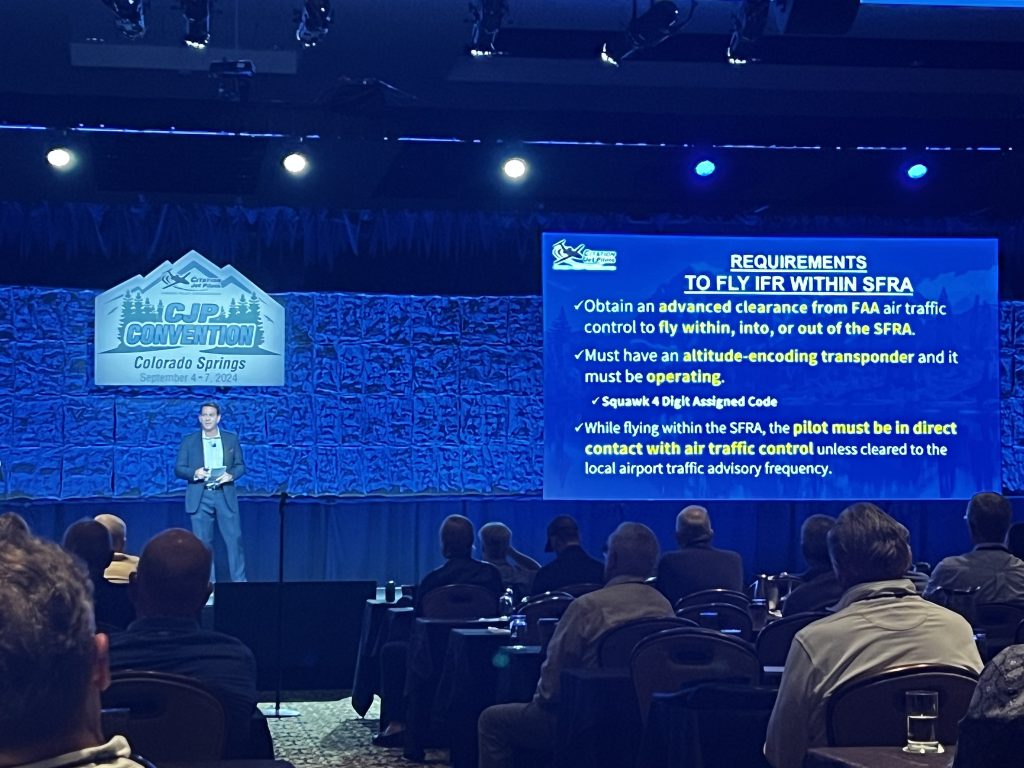Although TFRs and the Special Flight Rules Area (SFRA) and Flight Restricted Zone (FRZ) centered over Washington, DC are nothing new, general aviation (GA) pilots frequently run astray of regulations and violate prohibited areas. Consequences can range from federal agents waiting on the ramp upon landing to interception from armed fighter aircraft, fines and even jail time.

CJP CEO Rob Balzano presented an overview of the procedures, considerations and the “avoid suddenly finding yourself in your own private air show” factors when operating in and around restricted areas, including “the most heavily-guarded airspace in the United States” over DC.
Balzano emphasized the importance of reading and understanding TFRs. Each one is unique, he added, and may include inner and outer rings, particularly for VIP movements including presidential and campaign flight restrictions.
“Everyone’s checking NOTAMs before taking off, but those aren’t always very clear,” he said. “Technology has helped out a lot. You can also go to the FAA website [tfr.faa.gov] that gives you some graphical TFRs. AOPA members can sign up for their TFR email announcements. They’ll also give you any changes. I’ve found that very, very helpful.”
Operating within the SFRA can be an entirely different matter. Balzano – a retired USAF colonel and F-16 pilot and instructor – shared his experiences intercepting GA aircraft that ventured into the SFRA without clearance.
“You might wonder how these folks keep flying and not see the fighters,” Balzano said. “Well, I can tell you from being on the other side that it happens quite often. You could be heads down. You could be looking around, and depending on how the fighters come you may not be aware of the intercept.”
One example involved a Cessna 182. “I came up on the intercept and I looked in the cockpit,” he recounted. “There’s an older gentleman flying with maybe his son or grandson. And as we fly by, we’re looking, and they look, and they start waving. They think we’re giving them an air show! One of the nuggets you can take away from this is that the US Air Force does not give out free air shows.”
Balzano also detailed the various measures to ward off aircraft from intruding into the SFRA and FRZ, from intercept maneuvers such as flares, or “head butts” performed by fighter aircraft, to LED signboards mounted to “bright orange helicopters with flashing blue lights” that provide radio frequencies and instructions to depart the area and land.
In 2005, a Visual Warning System (VWS) was mounted to ground buildings around DC to warn pilots flying in restricted airspace without authorization. “That provides another layer of situational awareness to get your attention,” Balzano said. “It’s a Class I laser, both red and green, pointed at your aircraft. Maybe you’re not answering a radio call, maybe you’re off your flight plan. They are assessing what your intentions are.”
Balzano pointed to resources available for pilots, including the FAA’s Intercept Procedures card (available here) that provides a quick reference to the information detailed in the Aeronautical Information Manual (AIM.)
“NORAD – the North American Aerospace Defense Command – is in charge of all North American and U.S. airspace,” he said. “They detect anything flying. If something does come in – like a balloon from our friendly neighbors in China – there’s an assessment of its threat level. Our national military leaders then make that call to either let it go, or to intercept it and take care of it.”
Balzano was then joined by Al “Jethro” Wimmer, who worked four years as director of operations across the Continental United States NORAD Region (CONR.) He later moved to NORAD, where he operates civilian aircraft such as Beechcraft Baron twins and even Citation jets on practice intercepts. Wimmer was also part of the response to the June 2023 overflight of DC by an unresponsive Citation V that later crashed near Wintergreen, VA.
“We in the air defense sectors monitor for that phone call,” he said. “When we hear of an in-flight emergency, NORDO or anything unusual going on, we get paid to suspect the worst. So, we’re going to pay attention to it and start to ask, ‘is anything else happening here that fits a bad-type picture?’”